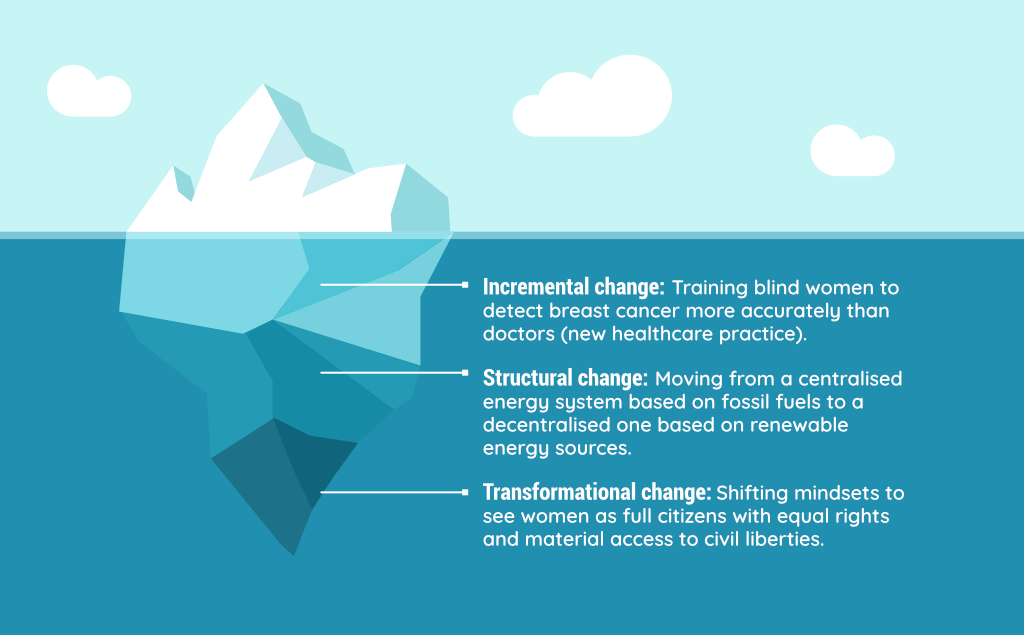About Systems Change
Catalyst 2030 members explore systems change approaches as a means of uniting in collective action to achieve the SDGs.
What is systems change?
Recognising there is no one set definition, Catalyst 2030 defines systems change below:
Systems Change
Confronting root causes of issues (rather than symptoms) by transforming structures, customs, mindsets, power dynamics and policies, by strengthening collective power through the active collaboration of diverse people and organisations. This collaboration is rooted in shared goals to achieve lasting improvement to solve social problems at a local, national and global level.
Resources categories
The iceberg illustration below shows different levels at which systemic change can take place: ‘deeper’ changes tend to result in greater impact but less dramatic shifts can pave the way towards these deeper changes.

Recommendations for Catalysing Systems Change
The Catalysing Systems Change framework provides four steps that will accelerate collaborative systems change, while changing the way we create change. To achieve systems change, local leaders in the communities where they have lived experiences with the problem, must ensure lasting impact.
Recommendations for catalysing systems change are highlighted in the boxes below. Scaling Solutions Toward Shifting Systems Initiative by Rockefeller Philanthropy Advisors has organised common systems change characteristics into a framework that is helpful to understand how to shift systems.
Adapted from Scaling Solutions Toward Shifting Systems Initiative (led by Rockefeller Philanthropy Advisors), see report
Catalysing Systems Change at Catalyst 2030
There are five key shifts that will accelerate collaborative systems change in Catalyst 2030 which catalytic networks need to pursue:
- Support dominant culture shifts towards equity
- Strengthen political and community engagement
- Strengthen systems-level funding
- Fuel collaborative action
- Develop and use systems change tools
We understand that the process of systems change is often challenging to implement. Systems change is not for the faint-hearted, it requires everyone to think and act differently. It forces programme managers to focus on outcomes, not outputs and foundations and programme managers to be willing to shift funding practices to long-term unrestricted funding (see Shifting Funding Practices). A willingness to listen is essential, not only for the “experts” but for practitioner “experts”, those local leaders solving the problem.
Creating systems change requires everyone to think and act differently.
A critical component of systems change is honouring the expertise of local leaders who are working closest to the problem. Those who design social impact programmes need to co-create solutions with local leaders to ensure the solution meets the needs of the community.
References
- Jackson, A., Montgomery, T., & Kania, J. (2020). Effective Change Requires Proximate Leaders. Stanford Social Innovation Review. https://ssir.org/articles/entry/effective_change_requires_proximate_leaders
- Badgett, A. (2022). Systems Change: Making the Aspirational Actionable. Stanford Social Innovation Review. https://ssir.org/articles/entry/systems_change_making_the_aspirational_actionable
- Savaget, P., Ventresca, M.J., Besharov, M. and Jacobson, J. (2022) Unpacking Systems Change Philanthropy: Five Alternative Models. Skoll Centre Working Paper. Oxford: Skoll Centre for Social Entrepreneurship.
- New Allies: How governments can unlock the potential of social entrepreneurs for the common good. (Led by McKinsey & Company)
- Scaling Solutions Toward Shifting Systems Initiative (led by Rockefeller Philanthropy Advisors), see the Scaling Solutions report.
